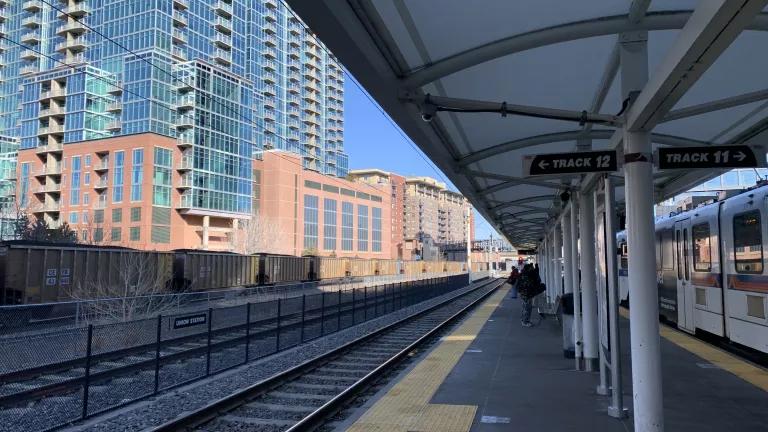Which Way for Colorado's Transportation Future?
The Colorado Department of Transportation (CDOT) is proposing a new greenhouse gas reduction rule this fall that would require the state and its regions to cut climate-warming pollution from transportation by investing more in sustainable mobility options.

The MAX bus rapid transit line in Fort Collins, Colorado is emblematic of the kind of clean affordable transit Colorado should invest in.
Jeffrey Beall, Creative Commons
The Colorado Department of Transportation (CDOT) is proposing a new greenhouse gas reduction rule this fall that would require the state and its regions to cut climate-warming pollution from transportation by investing more in sustainable mobility options. This could be a national model for state action on climate pollution from the transportation sector, but the proposed rule needs to more strongly prioritize the needs of communities that have been most harmed by the state’s past transportation infrastructure decisions.
NRDC is asking CDOT to adopt a strong rule that meets our climate goals and advances equity. The public comment period is open through November 18, 2021 at 12 noon MT. You can find out more about the rule and how to give your feedback here.
Picture this: you’re stuck in years of highway widening construction during your morning commute, yearning for new traffic lanes to finally open and provide relief—only to find a few years later that the highway and new lanes are just as filled with traffic as before. If that sounds all too relatable, it’s because it’s a universal truth that drivers have experienced over and over again for a century—we can’t build our way out of traffic with new and wider roads.
Yet that’s exactly what Colorado has in store for the next decade to the tune of 175 new lane-miles of freeway that will end up jammed with traffic and belching pollution. It’s a plan that shows we haven’t learned from our past mistakes. The smog that we see every day will only get worse and the people who live next to these highway expansion projects will breathe worse air.
A new NRDC interactive map, available in English and Spanish, reveals the potential impacts of Colorado’s current and planned highway expansion projects, including deepening the inequalities experienced by communities burdened by past transportation decisions and government actions, like urban renewal and redlining. Finally, the map explores some of the investments that could provide safer and more convenient alternatives to driving if we could kick our highway habit and invest in solutions that provide more mobility options, prioritize environmental justice, and reduce air pollution.
Learn More
Explore these interactive maps in English and Spanish.

Highway expansion projects perpetuate environmental racism and injustices by dumping more car emissions into already disproportionately impacted neighborhoods. Colorado’s transportation policies currently prioritize new car lanes instead of making public transit, carpooling, biking and walking accessible to all communities and building more affordable housing near transit.
Transportation is the single largest source of greenhouse gas (GHG) emissions, both in Colorado and nationwide, and a pollution source that disproportionately impacts low-income communities of color. One of the most polluted zip codes in America, 80216, which encompasses the neighborhoods of Globeville, Elyria-Swansea, and Park Hill, is bisected by the current I-70 expansion and adjacent to the proposed expansions of I-270 and I-25.
According to analysis from our partners RMI and Southwest Energy Efficiency Project, plans and projects underway to widen I-25, I-70, and I-270 are estimated to add over 175 new lane miles by 2030, which will generate “1 to 1.5 billion additional vehicle miles traveled (VMT) on Colorado roads per year. This would represent a roughly 2 percent increase over current Colorado VMT, equivalent to about 70,000 more cars, SUVs, and light trucks on roads annually.” That runs counter to the state’s goal of reducing vehicle miles traveled by 10% below anticipated 2030 levels, as outlined in the Colorado Greenhouse Gas Pollution Reduction Roadmap authored by Governor Polis.
In addition to taking us in the wrong direction on our climate goals, several of these projects are a step backwards in addressing long standing environmental injustices suffered by communities adjacent to these highways. Living near highways exposes residents to increased air pollution, noise, and other factors that harm human health and well-being. Many of these same neighborhoods were redlined in the late 1930s, a practice that institutionalized racism in mortgage lending and infrastructure investments.
Motor vehicles are one of the two largest sources of dangerous local air pollutants that form ground-level ozone (smog) and can cause respiratory problems and other health issues, particularly among children, seniors, and communities living near highways, which are often low income and/or communities of color.
Currently, the U.S. Environmental Protection Agency classified the Denver region as a “severe nonattainment” area when it comes to achieving federal ozone pollution standards. The Denver Metro area has the 10th most ozone pollution in the U.S. and is ranked third worst among cities outside California.
We must increase Coloradans’ options for safe, affordable, accessible, and convenient pollution-free transportation if we want to clean up the air, rectify environmental injustices, and meet our state goals of reducing emissions to 50% of 2005-levels by 2030 and 90% by 2050.
The maps show the projects and plans that can help reach those goals, including providing fast and convenient bus rapid transit lines, expanding local, regional and statewide bus services, making the most dangerous streets safer for everyone and building a comprehensive network of safe places to ride bikes
A current statewide rulemaking is an opportunity to align our transportation spending with our climate and environmental justice priorities. It’s our chance to clean up the dirty air that is harming our health, especially our kids, elderly friends and family, and communities located near busy highways. Join us in making sure that climate-friendly transportation choices are also the easy, budget-friendly, and efficient choices.





